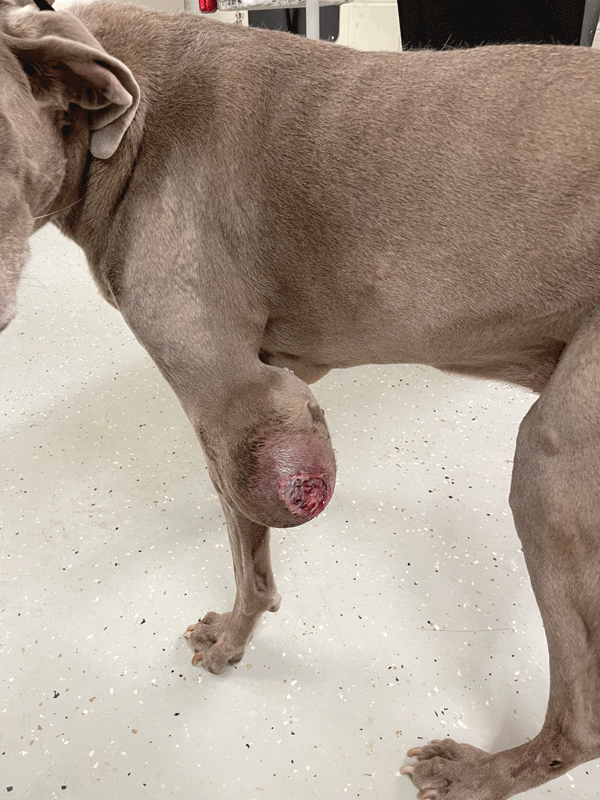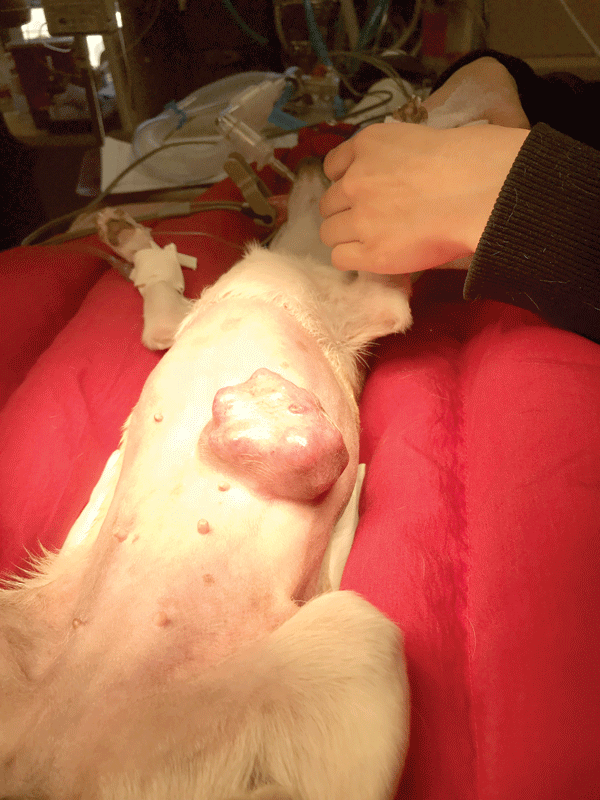The surgical oncologist must make many decisions before entering the operating room. Surgical planning for cancer patients requires information gained from diagnostics, knowledge and history of the tumor being addressed, and a discussion with owners regarding their goals for their pets.
Evaluating the patient’s overall health status is essential for planning the surgical procedure and anesthesia. Because cancer tends to affect the overall patient’s well-being, a complete blood count, serum biochemistry profile, urinalysis, and ECG are the minimal baseline data that should be acquired for all cancer patients. Assessment of overall nutritional status, co-morbidities, and the extent of cancer involvement guides the anesthetic protocol and the surgeon’s planned procedure.
Critical information includes the tumor type, the extent of possible metastasis, and tumor grade. These variables may not be wholly known, but all attempts to gain this information should be made. When actual knowledge of tumor type is not known, an astute clinician’s “best guess” should guide surgical planning. For example, a splenic mass on a geriatric golden retriever is believed to be a hemangiosarcoma until proven otherwise and should be treated as such.
Indeed, there is a risk of bleeding in gaining a biopsy of this type of mass percutaneously. Where appropriate, though, obtaining a biopsy or needle aspirate to learn the origin of the tumor should be made.

We have a mass … now what?
Now, what, indeed? In general, the more cells/tissues you collect, the better your chances of making an accurate diagnosis. Additionally, multiple samples collected are even better. One should always provide a detailed history to the pathologist to assist their interpretation. When small samples are collected, tissue cassettes are used, and samples from different masses should be separated into well-identified individual containers.
The surgeon must assess the risk/reward of obtaining a biopsy pre-operatively. Techniques for obtaining a diagnosis include impression smears, fine needle aspirate, needle core biopsy, incisional biopsy, and excisional biopsy.
The advantage of biopsy pre-op is it gives information, such as whether the mass is cancer or something else (such as a granuloma or inflammatory lesion). Also, the surgeon will possibly learn (if it is cancer) whether it is benign or malignant, which aids definitive surgical planning.
Impression smears may be helpful for cutaneous ulcerated masses or can be performed following a biopsy. The information gained may be useful, but this technique has limitations regarding the number of cells that may be obtained.
A fine needle aspirate is minimally invasive for most cutaneous and subcutaneous masses. The disadvantage of this technique is some tumors do not exfoliate well, and a limited amount of information may be obtained. For highly vascular masses, a diagnosis may not be possible because of blood contamination of the sample.
Needle core biopsies are more invasive and generally require a Tru-Cut biopsy instrument. Sedation is required for this type of biopsy, and a reasonably good sample may be obtained with this technique. Samples can be submitted for histopathology and rolled onto a slide for cytology.
The location for incisional biopsies should be carefully planned since definitive surgery should include excision of the biopsy site. Incisional biopsies should be obtained not from the mass’s direct center but from its periphery to acquire active cells. Often, the center of the mass contains necrotic tissue that may not be diagnostic.
Excisional biopsy may be definitive surgery when wide margins can be obtained. It may be considered a “debulking” surgery when wide margins are not attained. When incomplete margins are present, further surgery or adjuvant treatment should be considered for aggressive cancers.
What do we know about this tumor’s behavior?
Once we know we have cancer and what tumor type we are dealing with, attempts should be made to define possible metastasis. Based on knowledge of the tumor type and its biological behavior, staging should consider whether it spreads hematogenously, locally, or via the lymphatics.
Once this is determined, staging options include thoracic radiographs, lymph node aspirates, abdominal ultrasound, CT, MRI, or other advanced imaging options. This assists the surgeon in defining surgical options as well as the oncologist who will follow up with adjunct therapy.
Surgical oncology principles
Strict surgical oncology principles should always be followed when dealing with cancer. Complete resection should be attempted whenever possible. Do not forget about the deep margins of the mass. The surgeon should minimize local or distant tumor seeding with their technique. To facilitate this, the surgeon should minimize tumor handling to prevent cell exfoliation.
Additionally, the surgeon should change instruments and gloves between individual mass removals and the closure of the surgery site. As previously stated, the surgery should be planned to excise any biopsy tracts present.
The surgeon should avoid cutting into the tumor capsule at the time of surgery and should cover any ulcerated areas of the tumor to avoid contact.
When tissue is adhered to the tumor (such as the omentum with abdominal masses), the surgeon should excise any adherent tissue. Once the cancer is excised, the surgery site should be thoroughly lavaged. The surgeon should minimize skin tension and close any dead space when closing the incision.

Planning surgical margins
Owners should be consulted about their goals when planning surgical margins. These plans should consider tumor extension locally and the need for aggressive surgical resection vs. “debulking” or conservative resection. Once the tumor type is known, the biology and its possible metastasis should be discussed, as this may determine how owners feel about potentially curative vs. palliative resections.
Knowledge of tumor extension locally guides the surgeon concerning the width, height, and depth of tissue needed to (hopefully) achieve clean margins. Most cutaneous and subcutaneous tumors do not extend their deep margins beyond a fascial plane, so resecting this underlying tissue should be planned. For wide skin margins, skin flaps, free grafts, or radical procedures may be necessary to close the tumor site following resection. These should be carefully considered and planned.
Some general tumor margin resection guidelines include the following (these recommendations are largely based on opinions and experience). The width of the lateral margins is determined by tumor type:
- 1 cm for carcinomas and benign masses
- 2 cm for most mast cell tumors*
- 3 cm for soft tissue and bone sarcomas
- up to 5 cm for feline injection-site sarcomas
- Fascial barriers are used for deep margins
o Fascia is considered resistant to invasion by cancer cells
o One plane is usually adequate
- Injection site sarcomas – resection of 2 fascial planes deep Connective tissues, including muscle fascia, cartilage, and bone, are generally resistant to external tumor invasion and provide a natural tissue barrier.
*Mast cell tumors are a bit more unique, however. For mast cell tumors, the following guidelines are:
- 1 cm lateral margins result in complete histologic excision of 100 percent of grade I mast cell tumors and 75 percent of grade II mast cell tumors.1
- 2 cm lateral margins result in complete histologic excision of 100 percent of grade I and II mast cell tumors.1
- 1 fascial plane deep should be resected
- Minimal handling, premed with Diphenhydramine (1-2 mg/kg SQ 30-60 min before surgery)
- Resect 3 cm margins if able or for grade III tumors
Incomplete or narrow margins?
To help identify potentially incomplete or narrow margins when wide excision is impossible, the excised mass should be inked, or sutures should be placed to identify locations. This will help guide the surgeon in determining if further resection is necessary.
Remember, always to record the color or suture tag in which margin they are placed. When necessary, if additional surgery is required, the surgeon should always excise any previous scar en bloc with at least 1 cm margins, including the deep fascia. This tissue should always be submitted for histopathology.
Sometimes, narrow margins are difficult to interpret (i.e. margins reported to be 1-5 mm).
The surgeon and owner should decide whether to operate again or watch for recurrence in these cases. It has been reported that mean histologic margins may be 35 percent to 42 percent smaller than the surgical margins,2 so narrow margins may not necessarily be incomplete. Surgical and histologic margins may differ significantly for canine cutaneous and subcutaneous mast cell tumors in these cases. This may occur due to shrinkage of the sample following excision and fixation, extension of the MCT beyond palpable margins, or both. In these cases. histologic measurements may significantly underestimate the tumor-free margins in dogs with cutaneous and subcutaneous MCTs.
The first two rules of oncology, according to Dr. Jaffe
|
Conclusion
Careful consideration and surgical planning based on tumor type and biology will help guide the surgeon in successfully removing most cancers. Consultation with owners before surgery helps in surgical planning. By adhering to sound surgical principles, the surgical oncologist can minimize the spread of tumors and the need for a second surgery in most cases.
Michael H. Jaffe, DVM, MS, CCRP, DACVS, is an associate professor and the service chief of Small Animal Surgery at the Mississippi State University College of Veterinary Medicine (MSU CVM). Dr. Jaffe is a graduate of the University of Missouri College of Veterinary Medicine. Upon graduation from vet school, he practiced as a primary care veterinarian in St. Joseph, Mo. and Ft. Lauderdale, Fla. Jaffe then completed a one-year companion animal medicine and surgery internship, and a three-year small animal surgery residency at the Louisiana State University, where he also received his master’s degree.
References:
- Fulcher, Ryan P., et al. “Evaluation of a two-centimeter lateral surgical margin for excision of grade I and grade II cutaneous mast cell tumors in dogs.” Journal of the American Veterinary Medical Association 228.2 (2006): 210-215.
- Risselada, Marije, Kyle G. Mathews, and Emily Griffith. “Surgically planned versus histologically measured lateral tumor margins for resection of cutaneous and subcutaneous mast cell tumors in dogs: 46 cases (2010–2013).” Journal of the American Veterinary Medical Association 247.2 (2015): 184-189.
